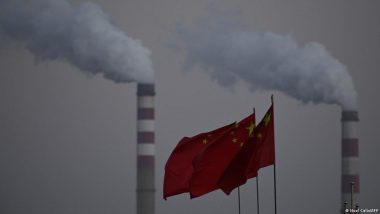China is a renewable energy leader but also keeps growing its dirty coal fleet and is the world's top polluter. So, is China on a high-speed green transition or are its fossil ambitions unstoppable?In early September as Typhoon Haikui swept across parts of eastern Asia, the colossal 123-meter (404-feet) blades of a wind turbine rotated furiously off the coast of Fujian, China. They generated enough electricity to power around 170,000 homes — the most ever produced in a single day by one turbine.
Also Read | India News | Rajya Sabha Adjourned Till Tomorrow; to Meet Again at 11 Am.
Manufacturer Goldwind's turbine was the biggest on the planet when it went online in June, only to be outdone just a few weeks later by another gargantuan structure also built in China. The world's second-most populous country is home to other massive renewables projects, including some of the world's biggest solar plants.
But China's green energy projects aren't only impressive in terms of scale. The country has seen huge growth in renewables capacity in the last few years too, said Yan Qin, lead analyst at financial market data provider Refinitiv.
In 2022, nearly half of the world's new solar, wind and hydropower capacity was deployed by China, according to the International Energy Agency.
"China's power sector moves very fast… its renewables growth is spectacular," Yan Qin, who is also a research associate at the Oxford Institute for Energy Studies, told DW.
Despite its global lead in renewables, China is the world's biggest emitter of climate-wrecking greenhouses gases largely caused by burning fossil fuels. Some 81% of its primary energy comes from coal, oil or gas. And the country's emissions have exploded from around 800 million tons annually in 1960 to 11.5 billion in 2021.
So, as world leaders gather for the COP28 UN Climate Conference in Dubai to agree more ambitious climate targets and stave off the worst impacts of planetary heating, does it all come down to what China does?
China: Climate villain or visionary?
China may emit more CO2 than any other country in world today, but the USA is the biggest historical emitter. That means the US is responsible for 17% of the emissions that have contributed to the climate crisis since 1850, with China at 12 %. Emissions per person are also much lower in China compared to the US — 8.73 versus 14.24 tons in 2021.
And China says it's planning massive expansion of renewable energy to replace fossil fuel. US President Joe Biden and Chinese leader Xi Jinping reaffirmed commitments to triple renewable energy capacity globally by 2030 at a meeting on the sidelines of the APEC summit in November.
China has already overachieved on some of its green energy targets. Non-fossil energy like solar and wind now accounts for over half of China's total capacity — a goal previously slated for 2025. The Asian nation is set to double its solar and wind capacity by 2025, bypassing its target five years ahead of schedule, according to a report from San-Francisco-based NGO Global Energy Monitor.
Favorable state policies are behind China's ability to rapidly build up its clean energy infrastructure in such a short time, said Li Shuo, incoming director of the China Climate Hub at the think tank, the Asia Society Policy Institute. Li added that other countries could learn from China's experience.
China's burgeoning solar manufacturing sector, for example, produces as much as 80% of all solar panels worldwide. That's significantly pulled down their costs globally and made solar the cheapest renewable energy in many countries.
"China is the largest manufacturing investor and also deployer of some of the most important clean technologies in the world," Li told DW.
Coal still on the rise
Despite the momentum behind clean energy, Li says China is still "heavily addicted" to the polluting fossil fuels powering its energy-intensive economy. Coal accounts for around 60% of China's energy generation, and more than 50% of its energy consumption, according to government figures.
"We actually burn more than half of global coal consumption every year," Li said. "The country can only be a climate leader with a clean revolution if you find ways to get rid of its addiction on coal."
Despite the goal to peak carbon emissions by 2030, the country has signed off on multiple new coal-fired power plants, as many as two per week in 2022 and the first half of 2023. Chinese officials further justified boosting the coal fleet as a way to ensure energy security in the face of the global energy crisis. China has abundant domestic coal supplies.
The country had previously promised to "phase down" coal use from 2026. But a few months ago, China's top climate envoy Xie Zhenhua said a complete phase-out of fossil fuels would be unrealistic if the country is to maintain economic growth and ensure a back-up power supply when the wind isn't blowing and sun isn't shining.
Paradoxically, the country needs coal to carry out its green energy transition, says Lin Boqiang, a professor with the China Institute for Studies in Energy Policy at Xiamen University.
"Without coal, renewable simply cannot go fast, because you cannot provide a stable power supply to get to that [energy transition]," he said.
But Lin maintains that though coal capacity is increasing, renewable capacity is growing faster.
In the first half of 2023, 52 gigawatts of new coal power gained permits compared to the 129-gigawatt growth in solar capacity alone this year.
But Li Shuo of China Climate Hub says the environment cost of burning coal is "tremendous," saying that instead of putting new plants online, China could be making energy savings elsewhere.
"And all of those costs are not necessarily factored into China's power sector. We should also harness the energy efficiency of this country," said Li.
New coal plants incompatible with climate goals
According to Carbon Brief, a UK-based website dedicated to climate coverage, China's CO2 emissions are likely to fall in 2024 due to "record growth in the installation of new low-carbon energy sources." Emissions could go into further decline "if coal interests fail to stall the expansion" of renewables.
"The first thing we need to do is to not approve to build more coal-fired power plants, and the second thing is to find ways to gradually reduce our coal consumption," said Li. "I hope there could be more progress in the next few years, and we will finally see the peak point of China's emissions."
Greenlighting new coal plants could still prove to be a stumbling block in achieving the Chinese government's goal of being carbon neutral by 2060 and achieving 80% of non-fossil fuel sources in its energy mix by 2060, said Li.
But Lin Boqiang is confident China is moving in the right direction.
"If you look at renewable increases, everything is on track. Even though you feel it's [the overall progress is] a bit slow, that's [China's] a developing country…energy demand is still growing," said Lin.
And for Yan Qin, the country has set itself up for success by keeping expectations low.
"These [goals] are not so ambitious, which is more or less what China typically did — not set the bar too high and then overachieve the target," said Yan.
Edited by: Jennifer Collins
(The above story first appeared on LatestLY on Dec 04, 2023 06:00 PM IST. For more news and updates on politics, world, sports, entertainment and lifestyle, log on to our website latestly.com).













 Quickly
Quickly


















